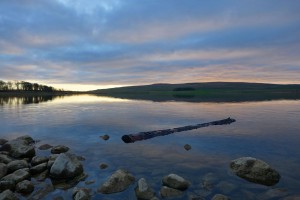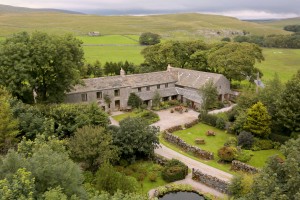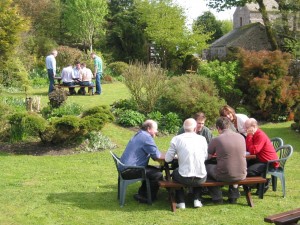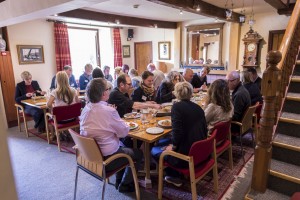Water on the brain
High on Malham moor in the heart of the Yorkshire Dales, a small corporate retreat has played host to many of the leading thinkers in the water industry. Overlooking the glacially formed lime-rich Malham Tarn, a Ramsar site (world class wetland) and magnet for nature lovers, it’s no surprise that High Trenhouse provides an inspirational environment for creative leadership thinking.
Coaxing key players away from the pressures of their daily environment into an alternative universe where, close to nature, there is time to think, John provided a place to reflect and find new direction at his Centre for Management Creativity.Making use of his Logo Visual Thinking technique (now an internationally recognised methodology that uses spatial arrangement to explore relationships between ideas) John facilitated leadership team thinking throughout the industry, both upstream and downstream, including contractors and suppliers such as Atkins Global, N G Bailey and BASF.
High Trenhouse also serves as a natural venue for management groups to bring their own facilitators to help them to meet the challenges of change. It was conceived as an environment to help managers break free from ‘more of the same’ mentality towards new levels of thinking that help them excel – in order to achieve more with less.
All management teams need help with their thinking processes. They also need help with their team processes and this venue, unlike a busy hotel, provides a watertight vessel for groups to focus.
Unique is a well-worn word, but when it comes to High Trenhouse, it’s pretty much on the mark. You won’t find it on many booking agency sites, because they don’t have a box to put it in. It’s not a hotel or a training centre. There is a bar, but there’s no Sky Sports. There’s no wedding going on in the other half of the venue. Instead, senior managers coming to High Trenhouse really do have exclusive use. A discreet hospitality team is on hand to provide supportive service. Thinking is not confined to the meeting rooms and participants can unwind in the sauna, relax in the colourful gardens and enjoy a quality of cuisine way above the average corporate hotel. There may not be a swimming pool or golf course, but the stunning Yorkshire Dales are the playground outside, with High Trenhouse literally on the Pennine Way, overlooking Malham Tarn and perched above the iconic Malham Cove.
Clients return time after time. Facilitators take their clients, directors take their managers, managers take their teams year after year. The common denominator is the leader who wants a spot away from the madding crowd for achieving exceptional outcomes from their group members.
Yorkshire Water has been tapping into the High Trenhouse source for more than 20 years. Former CEO of Yorkshire Water and Kelda Group Richard Flint recalls:
‘ High Trenhouse is a superb facility that allows management teams to remove themselves from the everyday pressures and concentrate on the bigger issues facing their businesses both strategic and personal. The remote location and fantastic staff make it a very special place where great work can be done.’
Yorkshire Water case study:
A flow of ideas
A case study – Yorkshire Water at High Trenhouse
This case study describes a process of building a shared, aspirational vision of the future. It details the process and explores the learning and shifts in perspective of those involved.
The process took half a day and was deployed as just one stage in an integral management team development programme at High Trenhouse.
Context
The senior executive commercial department of Yorkshire Water took the team members away from their everyday office environment to help them think through how to grow the business and organise themselves and their resources around their strategy.
Diagnostic interviews with individual senior players revealed conflicting views as to whether the team needed to exist as such, or whether individuals’ expertise could be more effectively employed disparately.
A development seminar was aimed at creating the context within which these views could be further explored and the relative merits of team cohesion brought to the fore. As integral aspects of the seminar, an exploration of inter-personal dynamics, creativity, current obstacles, issues and common purpose were useful in highlighting sameness and difference.
Process
Stage one – gathering
The group convened at High Trenhouse and, once refreshed, set to in the Northend conference room using Logovisual Thinking (LVT) techniques to explore responses to the question “Assume we have become successful as a team. What does it look like? What makes it work?” Their answers were recorded in the present tense to affirm their aspirational intent and were handwritten on the distinctive hexagonal magnetic media of LVT. Initially working in pairs, they spilled out to work in the sunshine and adjoining syndicate rooms, using laptops with Logo Visual software to capture what they had achieved with the magnetic media.
Stage 2 – clustering
Back in the conference room the groups cross-presented. With the laptops networked, it was easy to open and present each model in turn. By a process of abstraction and with much discussion the methodology enabled them to combine their respective outputs into a single integrated vision for the future. Not only did they combine the material from the different groups but the process served to bring the individuals into alignment. The role of the facilitator was mostly to guide the process while the content remained firmly in the hands of the participants.
Stage 3 – Design
After a break for lunch and time-out enjoying the tranquillity of the High Trenhouse gardens and its magnificent setting, the group reconvened to assess the integrated model and consider the systematic pattern of their combined efforts. They interpreted some aspects as drivers or ‘means’, others as outcomes and others as aspects that would be achieved incidentally to their main focus.
Observations
A transition in strategic perspective
The process of working in an environment centred wholly on mental creativity provided a series of interactions with the same material, each of these evoking an increasing sense of ‘stepping back’ to a more strategic perspective. Being in beautiful surroundings away from the daily distractions of their regular workload gave the team members a more objective and creative perspective.
Conclusions
The team in this case needed the opportunity to explore their mutual aspirations and identify how they were to align in order to produce a result. Being away from their busy office with the daily distractions of their regular workload, gave the team members a more objective perspective and crystal clear picture of where they should be aiming. It enabled them to acknowledge a common language for engaging with each other in moving in the right direction. Incidental to the main purpose, the process achieved much more – transitions in ownership, awareness and strategic perspective and a quality of dialogue and interaction rarely experienced in conventional business processes.
” High Trenhouse creates a unique atmosphere of tranquility in a stunning location where business teams can take time out from the day to day pressures and think about long term strategy or focus on personal or team development.” Paul Wynn, former Yorkshire Water Commercial Manager.




